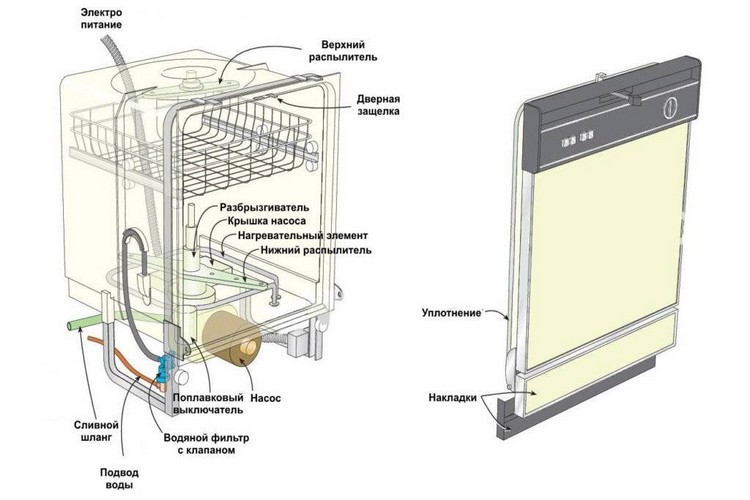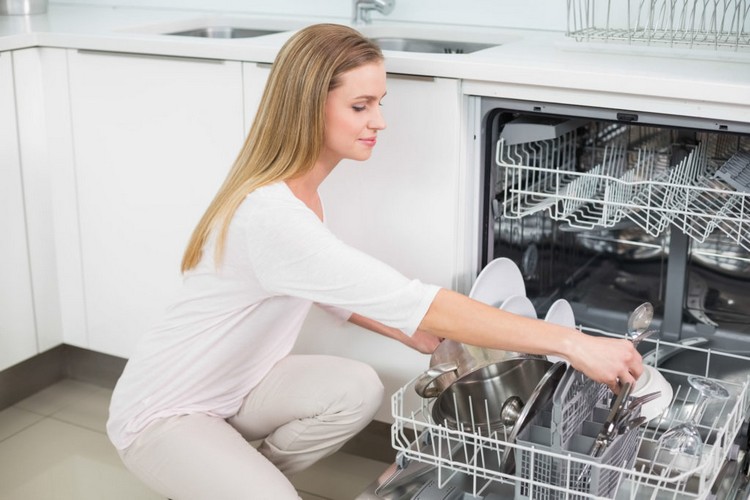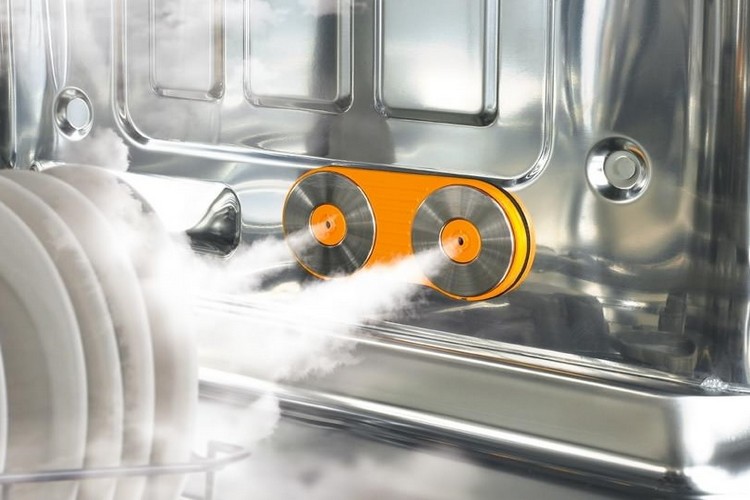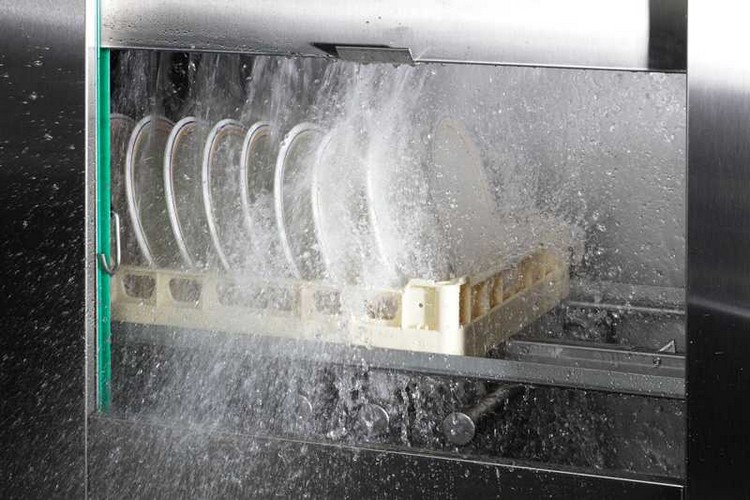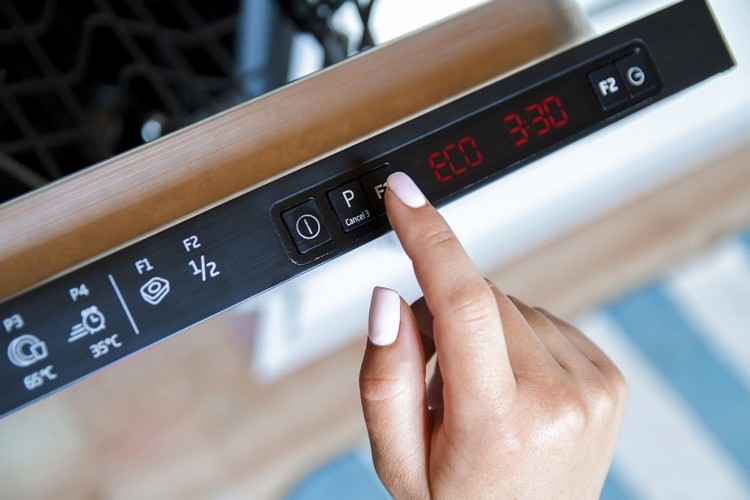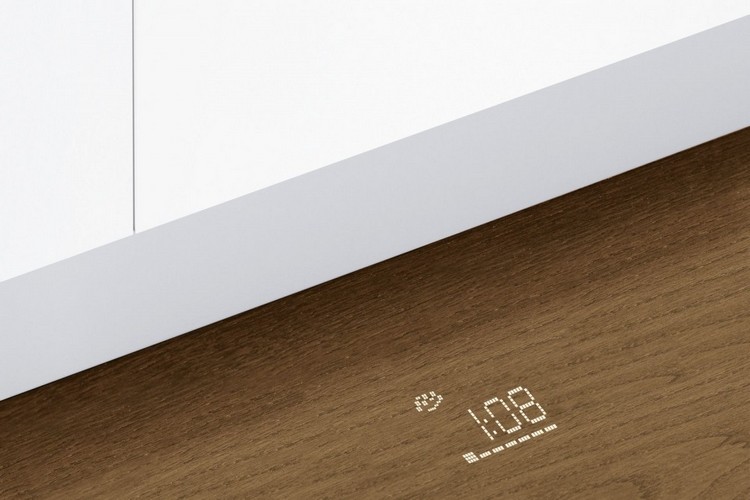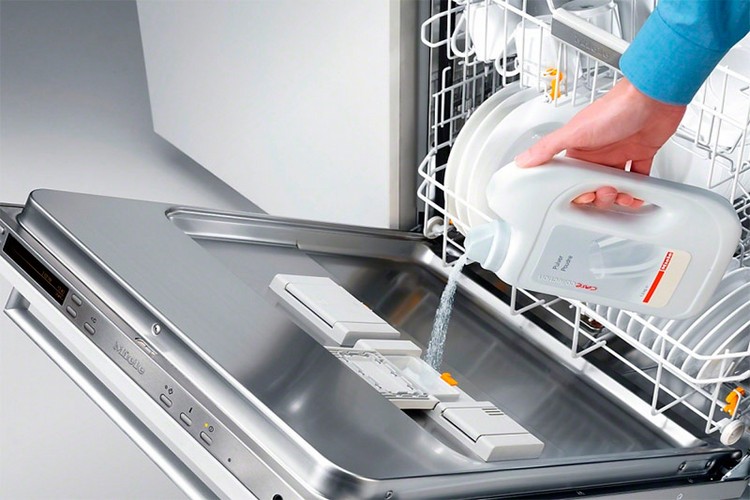The description of how a dishwasher works: principle of operation, rules of operation and care
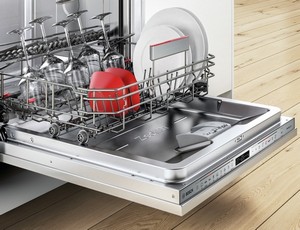 Most of the automatic dishwashers currently offered in stores are front-loading models built into the kitchen set.
Most of the automatic dishwashers currently offered in stores are front-loading models built into the kitchen set.
Such appliances simplify housewife's life to the maximum.
Just place dirty cutlery in the dishwasher, press the button - and after a short time spoons, forks and plates are clean again.
The dishwasher requires water, regenerating salt and detergents to operate properly and to wash dishes thoroughly. The water jets must have a set temperature, the salt composition must meet the NaCl purity requirements, and the washing liquids and tablets must be suitable for the specific model.
Each part of the dishwasher is responsible for its own part of the dishwashing process. If the heating element doesn't heat the water sufficiently, the pump doesn't pump it fully, and the ion exchanger or filters get clogged, the dishes will be left dirty.
Contents
- General principle of dishwasher operation
- Dish preparation and loading
- Stages, washing cycles
- Extra rinse mode
- Drying class
- Dishwasher modes and extra functions
- Dishwashing completion time
- Beam on floor
- Preventive maintenance and cleaning of the automatic dishwashing machine
- Maintenance of the automatic dishwashing machine
- Useful video
General principle of operation of a dishwasher
The principle of its operation is quite simple.
First, the device draws water, then heats it to the desired temperature with the help of a heating element. The heated water is mixed with the detergent and the resulting solution is delivered to the atomizer units located at the top and bottom of the machine's chamber. The sprays, rotating, spray jets of soap solution in different directions and at different pressures.
This allows all surfaces to be treated evenly, which greatly reduces the likelihood of streaking. Next, soapy water enters the drainage pipe, and through it the water is taken outside, but without any residual detergent. Thus, the machine cleans itself, without requiring human intervention.
Preparing the dishes and loading
There are clear rules about how to load the dishes and cutlery into the dishwasher hopper:
- Before you load the dishes into the machine, you must clean off any food debris:
- All items should stand stably;
- The dirtier utensils are placed in the bottom box of the dishwasher;
- Place all containers upside down so that water does not accumulate in them;
- Do not place tall or narrow containers in corners or at an excessive angle;
- Do not load the dishes into the machine more than once;
- Do not load more than half the capacity of the dishwasher;
- Do not load forks, spoons and knives into the machine;
- Do not place any pots, pans without handles or cast iron pans on the top plate of the machine;
- Close the door of the machine tightly so that there are no gaps.
If necessary, you can place more dishes in the machine, but do not forget that their weight should be even. Correct loading of the dishwasher ensures quality and long-lasting dishwashing performance.
It also saves time and detergents. On the other hand, if the dishes are loaded unevenly, they may not rinse properly due to uneven friction. This is especially true for pots and other items that have smooth surfaces.
If you load the dishwasher incorrectly, you may end up with dishes with dried-on dirt and food residue. If you improperly prepare your dishes, they will quickly become clogged with dirt and poorly cleaned.
Stages, wash cycles
Let's take a look at what stages the dishes go through in the washing process.
In fact, there are not many of them:
- Pre-soaking. Jets of water dislodge food debris from the dishes, its preparation for further processing takes place;
- Washing. Dishes are washed with jets of hot water with a special agent dissolved in it.
- Rinsing. Using hot water, remove detergent residues from the dishes. Depending on the algorithm of the control program or information received from the sensors, the water can change several times during the rinse.
- Drying. Moisture is removed from the surface of the dishes. The dishes are then completely washed and dried and can be placed back in their usual place.
Extra rinse mode
The dishwasher's extra rinse mode is provided in each of the programs you use. For some of them, the water is heated, while others use cold water.
However, sometimes the standard rinse mode is not enough. In wash cycles, this function is provided to rinse the detergent and make the dishes shine. But if the containers have been heavily soiled, food particles may remain on them even after several rinses.
If you wash your dishes just once in the evening, they may stay in the dishwasher for several hours. During this time, the remains of food on plates, pans and pots will dry. During washing it will be very difficult to remove them, and particles of dirt may remain on the dishes.
To avoid this, use the pre-rinse mode. It is recommended to turn it on before using the main cycle, or even 2-3 times during the day, so that food residues do not dry on the dishes until you fully load the dishwasher. No detergent is used when the dishwasher's rinse mode is turned on.
Drying Class
In addition to "energy class" and "wash class", modern dishwashers also have such an option as "dry class". It is determined - by performing test measurements. Depending on how much water is left on the dishes, the machine is assigned a class A, B or C.
Drying class A or B is a perfectly acceptable option. Class A means that the manufacturer promises us perfectly dry dishes. Class B and C allow for some moisture (drops) on the dishes.
Dishwasher modes and additional functions
Dishwasher control is not difficult, basic principles and rules of use, as well as dishwasher modes will facilitate the work of any housewife.
The dishwasher has two main modes of operation - these are:
- fast;
- intensive.
The fast mode is the most gentle washing of dishes, which does not require additional rinsing or drying.
Intensive washing mode is designed for more thorough, thorough washing of dirty dishes.
On models that have a delayed start timer, once it is set, you can set the dishwasher to run for a specific time so that it will wash the dishes by the time you need them.
There are also additional functions, such as: self-cleaning and leakage protection.
Self-cleaning is an additional feature that will save you water and electricity, and significantly reduce salt consumption. This function is very convenient in case you use the dishwasher at home and do not want to change the salt often.
The "Leak Protection" function is also an optional feature. Turning it on will prevent water from flowing to your appliances in the event of a leak. This will prevent serious damage in the event of flooding.
Time to finish the washing of your automatic dishwasher
When the dishwasher completes the wash cycle, the appliance emits a signal and finishes.
On the control panel there are handy indicators of the end of the program, using the settings you can change the volume of the sound signal or turn off the alarm for the end of work.
This is especially relevant when loading dishes overnight.
After stopping the machine completely, press the off/on button of the machine.
Ray on the Floor
Most commercially available dishwashers are recessed. They are installed in a kitchen unit, and the front of the unit is covered by a furniture front.
The controls are on the top edge of the door, so they are not visible unless you open it. Manufacturers are trying to make the appliances work as quietly as possible, so you can not always tell right away if the washing cycle is over or not.
So that users don't have to listen or open the door, some dishwasher models are equipped with a "Ray on the Floor" feature
"Floor beam" in a dishwasher is a light projection to help keep track of the appliance's progress. It can work in several ways.
Sometimes the light dot near the door of the dishwasher appears only when the program is finished. In other models, on the contrary, it goes out after the appliance finishes its work. There is another option - changing the color of the beam from red to green. And the most complicated one is projecting on the floor not just a point of light, but the time left till the end of the program.
The Beam on Floor function allows you to do without a beep at the end of the dishwasher. This option will be appreciated by families with small children, as well as those who usually turn on the machine at night.
Preventive Maintenance and Cleaning the Dishwasher
To avoid questions about how to clean the dishwasher, you need to "clean" the inside of the appliance after each use, if possible.
Simple tips:
- If you use the appliance daily rather than on holidays, you can avoid grease and food residue from drying out.
- Before washing the dishes in the dishwasher, they should be rinsed with hot running water to wash away food residues and some of the grease.
- It is obligatory to wipe the door and gaskets with a damp cloth with detergent after each use. If dirt gets into them, over time, an unpleasant smell of rot may appear.
- Clean the appliance periodically with vinegar. To do this, pour two cups of liquid on the bottom of the dishwasher and turn on a quick wash without dishes.
- To combat the smell, you can pour a glass of baking soda in the bottom of the appliance and use the machine as usual.
- After each use, leave the door of the machine open to allow it to dry inside.
Maintaining the oven
The surfaces of the washing chamber are the first to require maintenance. They are made of stainless steel, which imposes certain restrictions on the cleaning agents used.
Do not use agents that contain chlorine and abrasives. They can ruin the surface, leaving indelible stains and deep scratches.
As a rule, surfaces are wiped with a soft cloth lightly moistened in a detergent solution. In most cases, manual cleaning of the washing chamber is absolutely unnecessary. It's all about the detergents used for washing dishes. If quality detergents are used, and the regenerating salt and rinse aid dispensers are set correctly, the internal surfaces will be cleaned together with the dishes.
The instructions for use describe how to properly adjust the salt and rinse aid consumption. Here it is important to understand that the hardness of tap water and other parameters vary depending on the region, so the dosage is often adjusted experimentally: after completing the washing cycle assess the condition of the inner surfaces, and if necessary, adjust the salt and rinse aid consumption level.
In especially "neglected" cases, the chamber walls are wiped with a soft cloth soaked in table vinegar. Or, a container (100-150 ml) of vinegar is placed in one of the baskets of an empty dishwasher and the cycle is started, after which the chamber walls are washed with a dishwashing detergent.
Special attention should be paid to the gaskets of the door of the machine. Lime scale accumulates on them, preventing a normal fit.
Remove these contaminants with a sponge or cloth soaked in table vinegar.
To prevent corrosion on the dishwasher baskets made of enameled metal rods and other elements of the dishwasher, it is recommended to wipe them dry after each use.
To prevent condensation from forming inside the chamber, leave the door open until the dishwasher is completely cooled down.
In the case of a non built-in (freestanding, tabletop) model of the dishwasher, the user will also need to pay attention to its outer surfaces. They are cleaned with a slightly damp sponge or cloth soaked in detergent solution.
Like any other appliance, the dishwasher requires proper and regular care. Service and maintenance procedures are not complicated and will not take much time, but if they are ignored, the dishwasher will turn into a piece of furniture and will no longer be able to perform its direct functions.
Useful Video
This video shows how a dishwasher works from the inside and what processes take place inside it when you're washing dishes:



